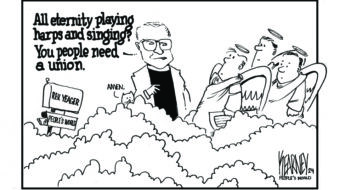Someone has pinched the heart of St. Lawrence O’Toole, and thereby hangs a typical Irish tale filled with metaphors, parallels, and some pretty serious weirdness.
Who done it? The suspects are many and varied.
Could the heist from Dublin’s Christ Church Cathedral have been engineered by the infamous “troika” of the European Commission, the European Bank, and the International Monetary Fund? Seems like a stretch, but consider the following: O’Toole-patron saint of Dublin-was, according to the Catholic Church, famous for practicing “the greatest austerity.” Lawrence liked to wear a hair shirt underneath his Episcopal gowns and spent 40 days in a cave each year.
That is a point of view the troika can respect. They have overseen a massive austerity program in Ireland that has strangled the economy, cut wages 22 percent, slashed education, health care, and public transport, raised taxes and fees, and driven the jobless rate up to 15 percent – 30 percent if you are young. At this rate many Irish will soon be living in caves, and while hair shirts may be uncomfortable, they are warm.
There are other suspects as well. For instance, St. O’Toole was friendly with the Norman/English King Henry II, who conquered the island in 1171. The Irish are not enamored of Henry II, indeed most of them did their level best to drive the bastard into the sea. Not Lawrence. He welcomed Henry to Dublin and, according to the Church, “Paid him due deference.”
So “deference” establishes yet another suspect: the current Fine Gael/Labor ruling coalition. Fine Gael leader and Irish Taoiseach (Prime Minister) Edna Kenny has already signed the new European Treaty, but was forced to put it up for a public referendum at home (no other EU county is being allowed to vote “yea” or “nay”). Kenny is pressing for a “yes” vote, and Labor’s Tánaiste Eamon Gilmore argues that a “yes” vote would be a “vote for economic stability and a vote for economic recovery.”
The Treaty will not only continue the austerity program, it will move decision-making to EU headquarters in Brussels. This means that governments will be powerless when it comes to the economy. Think “Model United Nations” and lots of earnest high school students.
Who will make these decisions? Good question. Well, it turns out that a committee of the German Bundestag debated the Irish austerity proposals before the Dublin government even got a chance to look at them. How did that happen? Again, good question, but no answer yet.
Maybe German Chancellor Andrea Merkel lifted O’Toole’s heart. She certainly has a motive: Merkel is leading the “austerity is good for you” charge, a stance that has battered economies from Spain to Greece. In any case, the Irish are already suspicious of the German chancellor. An anti-austerity demonstration outside the Dail, Ireland’s parliament, featured a poster calling government ministers “Angela’s Asses.”
Much of the economic crisis in Europe-and virtually all of it in Ireland- is due to the out-of-control speculation by German banks, along with the Dutch, Austrian, and French financial institutions. “Yet it is the working people of Ireland and Europe who are being asked to pay the price,” argues Des Dalton of Sinn Fein. It appears that the Germans have discovered that one does not need Panzer divisions to conquer Europe, just bankers and compliant governments.
“Compliant,” however, has run into some difficulties in Ireland, a place where “difficulty” is a very common noun. On Mar. 2, Sinn Fein President Jerry Adams trekked out to Castlebar in the west of Ireland to resurrect the ghost of Michael Davitt, founder of the Land League and leader of the 1878 Land War (there was an earlier one from 1761 to 1784, but more on that later). Adams told the Mayo County crowd “The Irish people cannot afford this treaty.”
The Castlebar symbolism was about as heavy as you can get. Davitt, along with the great Irish Parliamentarian Charles Stewart Parnell, launched the land war from that city, calling up the words of the great revolutionary, James Fintan Lalor: “I hold and maintain that the entire soil of a country belongs by right to the entire people of that country.”
These days that is not a popular sentiment in most European capitals, where governments are shedding public ownership in everything from airlines to energy production. The Irish government is trying to sell off several lucrative holdings, including Aer Lingus, Ireland’s natural gas company, and parts of its Electricity Supply Board. The state’s forestry will be sold as well. “It is the depth of treachery to sell billions of Euros worth of State assets to pay bad gambling debts,” Socialist Party member Joe Higgins said in the Dail.
The land wars were a reaction to efforts by the English to apply to Ireland the Enclosure Acts, a policy that sold “common land” to private landowners and forced the rural population of England, Scotland and Wales into the hellishness of industrial Manchester, Birmingham, Glasgow and Liverpool.
As Laura Nader and Ugo Mattei maintain in their book “Plunder: When the rule of law is illegal,” what is currently happening in Ireland (and all over Europe) is a 21st century version of the Enclosure Acts. The last vestiges of public ownership are being systematically auctioned to the highest bidder, and the concept of “the common good” is fading like the ghost of providence.
But not without a fight.
While Adams was resurrecting the spirit of Michael Davitt, demonstrators were besieging Parliaments in Greece, Spain and Romania.
Ireland rejected two previous European treaties, only to pass them in a second round of voting. However, under the new rules, it no longer has veto power. If 12 out of the 17 Euro Zone countries endorse-pretty much considered a slam-dunk-then the new treaty goes into effect.
A number of commentators are saying that the 12 country threshold makes the Irish referendum irrelevant, but a “no” vote will be a blow to the Euro currency, and it might eventually encourage similar “no” votes in other countries. In that sense, the Irish tail could end up wagging the European dog.
Since Irish stories always include parallels, there is certainly one to be made between the first land war and the current debt crisis. The 1761 effort by English landlords to apply the Enclosure Acts to Ireland ignited resistance, first in Limerick, then spreading to Munster, Connacht and Leinster. Crowds of Irish tenants dressed in linen masks and coats-hence their generic name, the” Whiteboys”- burned hayricks, knocked down enclosure walls, and hamstrung cattle. On occasion they pitched land agents into the local bog.
The Irish resistance to the Enclosure Acts was not unique, but a very odd thing happened in Ireland: they won. A combination of population growth and war had driven up the price of food, so even the small-scale agriculture practiced by the Irish was profitable. Plus the rent capital skimmed off the Irish peasantry was playing an important role in helping to capitalize the English industrial revolution. Add to this the resistance, and the English decided that it was in their best interests to back off.
The average Irish tenant knew nothing about international finance or capital accumulation, but they got the idea that if you dug in your heels and went toe-to-toe with the buggers, you could beat them. It was a momentous experience, and a collective memory that would help fuel more than 150 years of rebellion.
Can the current Irish resistance movement turn the tide against the austerity madness that has gripped the European continent? Well, the Left is on the rise (in some places, so is the Right). Sinn Fein’s support in the most recent opinion polls shows a 25 percent approval ratting, up 4 percent. In comparison, Fianna Fail-the party that ushered in the current crisis-has dropped from 20 percent to 16 percent. Labor has fallen to 10 percent, and Fine Gael is at 32 percent. Other Left parties are also doing well.
Indeed, the Left seems to be resurging in other countries as well. A center-left party in Slovakia ousted a right-wing government, and France seems posted to vote socialist. The Greek Left is fractious, but its various stripes now make up a majority.
Weirdness. Remember weirdness? For starters, an 832-year-old heart is pretty strange. And it wasn’t just the heart that was snatched. Someone also stole a splinter of the “true cross” (if one added up all the splinters in all the Cathedrals of Europe you end up with a fair size forest). And then there is the matter of the cheekbone of St. Brigid that just missed getting lifted from a church in North Dublin.
In the end, saints will not preserve Ireland from an invasion of the austerity snakes. The Irish people will have to do that. But they sport an impressive track record of overturning imperial designs, and they have long memories: put enough people into the streets of Castlebar (Dublin, Cork, Waterford, Galway, Limerick, etc) and the bastards will back off.
As Adams said in Castlebar, “Stand together, stand united, and there is nothing we cannot achieve.”
Read Conn Hallinan at Dispatches from the Edge and middleempireseries.wordpress.com.

MOST POPULAR TODAY

High Court essentially bans demonstrations, freedom of assembly in Deep South

U.S. imperialism’s ‘ironclad’ support for Israel increases fascist danger at home

Zionist organizations leading campaign to stop ceasefire resolutions in D.C. area

UN warns that Israel is still blocking humanitarian aid to Gaza

Resource wars rage in eastern Congo, but U.S. capitalism only sees investment opportunity






Comments